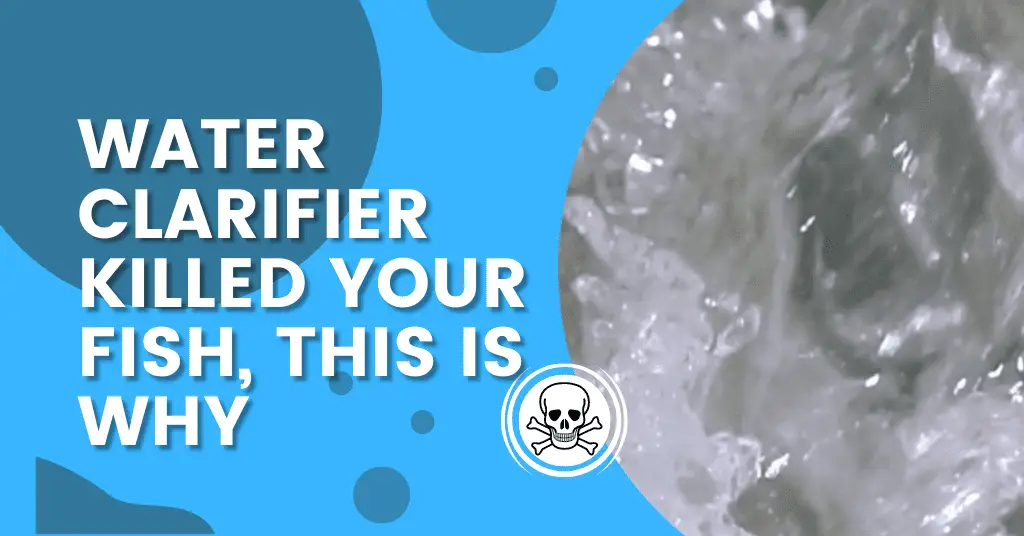Last Updated on July 16, 2022 by cmoarz
Stirring up the substrate, especially dirty or powdery substrate, can release a lot of cloudiness into the water.
Most people first think to grab a water clarifier and dump some into the tank to help settle the particles. But wait, the Water clarifier killed my fish? What happened?! This stuff is supposed to be nontoxic right?
Yes, But, it’s more complicated than that, and there’s something most people don’t know about water clarifiers, even some experts. let’s get started.

What water clarifiers are and what they do to aquarium water
Table of Contents
To understand why the water clarifier is responsible for killing your fish, we need to know a little bit about how it works.
Most water clarifiers work by using a flocculant called aluminum chlorhydrate. This substance binds to small particles in the water and clumps them together so that they can be more easily filtered out or settle to the bottom.
Normally, this chemical is safe for fish, Completly none toxic, and either eventually get filtered out or settles at the bottom of the substrate, and ends up getting removed during subsequent water changes.
But there is something they don’t tell you about aluminum chlorhydrate. Let’s dive in!

This is why the water clarifier may have killed your fish
Normally, in ideal tank conditions, the aluminum chlorhydrate will be perfectly safe. It will do it’s job as designed and help remove particles suspended in the water column just fine.
But when things go wrong, the aluminum chlorhydrate can have disastrous consequences for your fish.
The main problem here is the KH level of your tank. KH, or carbonate hardness, is a measure of the buffering capacity of your aquarium water. This is what prevents sudden changes in pH.
KH is measured in degrees KH, or ppm (parts per million). Most aquariums should have a KH between 6 and 8 (so around 140ppm).
When the dKH level drops too low, in this case, below 6ppm, the aluminum chlorhydrate can start to become extremely toxic to your fish.
The aluminum chlorhydrate will start to bind with the carbonates in the water, causing them to be removed from the water. This causes the dKH level to drop even further, and the aluminum chlorhydrate to become increasingly toxic.
In a short period of time, this can lead to a sudden and dramatic drop in pH, and the death of your fish.
So, how can you prevent this from happening?
The first thing you need to do is make sure that your aquarium has a stable KH level. Unfortunately, Most test strips or cheap test kits don’t measure KH levels, so you may need to buy a separate KH test kit.
Once you know the KH level of your aquarium, you need to make sure it stays above 6 degrees dKH before you use a water clarifier.
Unfortunately, there isn’t much you can do to reverse the damage that’s been done other than removing the surviving fish from the tank and doing several 100% water changes.

When you should use a water clarifier to fix a cloudy tank
Most people are able to use a water clarifier without any problems. However, We at aquariumgravel.com really don’t recommend using them at all.
The truth is, Yes, they do work. And if your dKH levels are fine, Your probably not going to have any problems using one.
But we’ve seen too many people run into problems because they didn’t realize how important dKH levels are, and how quickly the aluminum chlorhydrate can become toxic when the KH level drops too low.
Besides, there is an even more effective way to remove small particles and cloudiness from your aquarium water, and it costs 10x less than using a water clarifier.
Simply place filter floss in your filter. Filter floss is perfect for catching all those small particles that are suspended in the water column and causing your water to be cloudy.
It’s also much less likely to cause any problems with your KH levels, and it’s much easier to remove if you need to (just take it out of the filter and throw it away).
So, unless you’re absolutely sure that your dKH levels are stable and above 6, we recommend that you avoid using a water clarifier altogether.

Can you use too much aquarium water clarifiers, and is it harmful to your fish?
You can definitely use too much water clarifier. While an overdose shouldn’t do too much damage directly to your fish and clear itself up in a few days (assuming your dKH levels are normal and above 6), Secondary effects can hurt your fish.
When you add too much clarifier, it starts to do the opposite of what it’s supposed to do.
Rather than remove the cloudiness as you expected, your tank may start to become more cloudy. A dark brown or red color may even start to form.
This happens because the aluminum chlorhydrate begins to bind with the organic materials in your aquarium, rather than just the small particles.
Not only does this not solve your cloudy water problem, but it also can lead to a sudden and dramatic drop in pH levels as the aluminum chlorhydrate reacts with the organic matter.
Your fish may become sick or even die as a result of this sudden change in pH. So, it’s important to be very careful when using aquarium water clarifiers, and make sure you don’t use too much.
If you’ve overdosed your aquarium with a water clarifier, the best thing you can do is to do several large water changes (50% or more) until the cloudiness clears up and your pH levels stabilize.
You should also avoid using any other chemicals in your tank while the cloudiness is clearing up, as this could further destabilize the pH levels.
Stick to filter floss and mechanical filtration for things like this. It just works better.

Why did a water clarifier make your freshwater aquarium even cloudier?
You’ve probably used too much clarifier! Always follow the guidelines and instructions on the back of the clarifier package for your gallonage.
About
Owner of AquariumGravel.com and also owner of actual Aquarium Gravel believe it or not! ;). Setting up beautiful aquarium sceneries and habitats since I was very young. Enjoy!
- Web |
- More Posts(290)

